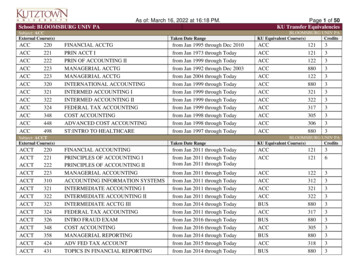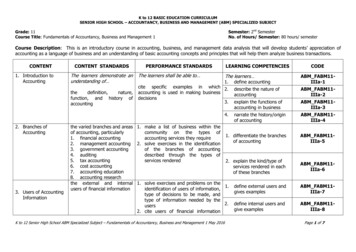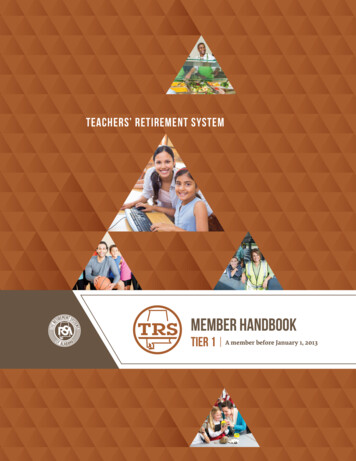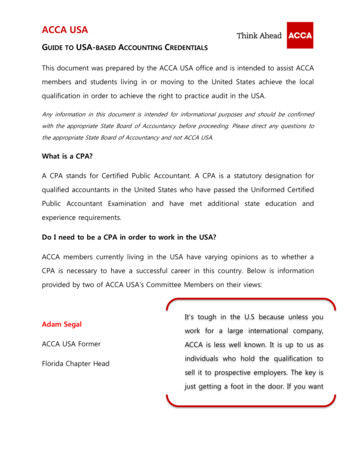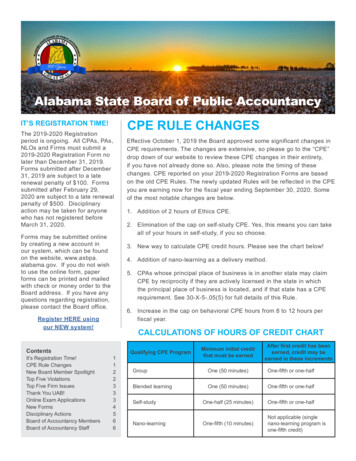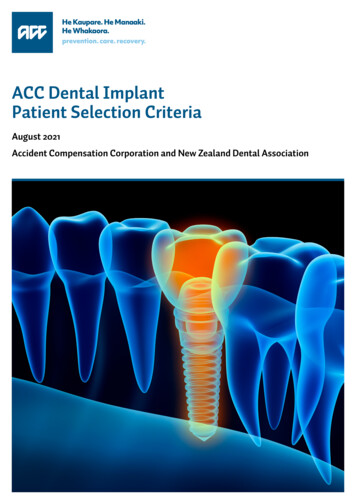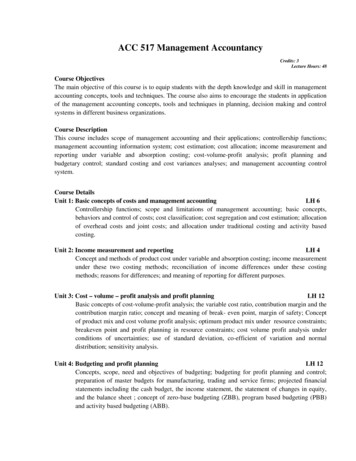
Transcription
ACC 517 Management AccountancyCredits: 3Lecture Hours: 48Course ObjectivesThe main objective of this course is to equip students with the depth knowledge and skill in managementaccounting concepts, tools and techniques. The course also aims to encourage the students in applicationof the management accounting concepts, tools and techniques in planning, decision making and controlsystems in different business organizations.Course DescriptionThis course includes scope of management accounting and their applications; controllership functions;management accounting information system; cost estimation; cost allocation; income measurement andreporting under variable and absorption costing; cost-volume-profit analysis; profit planning andbudgetary control; standard costing and cost variances analyses; and management accounting controlsystem.Course DetailsUnit 1: Basic concepts of costs and management accountingLH 6Controllership functions; scope and limitations of management accounting; basic concepts,behaviors and control of costs; cost classification; cost segregation and cost estimation; allocationof overhead costs and joint costs; and allocation under traditional costing and activity basedcosting.Unit 2: Income measurement and reportingLH 4Concept and methods of product cost under variable and absorption costing; income measurementunder these two costing methods; reconciliation of income differences under these costingmethods; reasons for differences; and meaning of reporting for different purposes.Unit 3: Cost – volume – profit analysis and profit planningLH 12Basic concepts of cost-volume-profit analysis; the variable cost ratio, contribution margin and thecontribution margin ratio; concept and meaning of break- even point, margin of safety; Conceptof product mix and cost volume profit analysis; optimum product mix under resource constraints;breakeven point and profit planning in resource constraints; cost volume profit analysis underconditions of uncertainties; use of standard deviation, co-efficient of variation and normaldistribution; sensitivity analysis.Unit 4: Budgeting and profit planningLH 12Concepts, scope, need and objectives of budgeting; budgeting for profit planning and control;preparation of master budgets for manufacturing, trading and service firms; projected financialstatements including the cash budget, the income statement, the statement of changes in equity,and the balance sheet ; concept of zero-base budgeting (ZBB), program based budgeting (PBB)and activity based budgeting (ABB).
Unit 5: Standard costing and cost controlLH 10Concept of standard costing and its application to cost control; direct material and direct laborcosts variances under standard costing; flexible budgeting and overhead costs variances (threevariances); analyses of the reasons and interpretation of costs variances; implication of thevariances for management control and performance evaluation.Unit 6: Management accounting and control systemLH 4Concept, need and scope of management accounting and control systems; the value chain; totallife cycle costing; target costing; kaizen costing; bench marking; balanced scorecard; behavioralconsiderations in management accounting and control system.Teaching MethodologyThe teaching methodology of management accounting will include a combination of interactive classlectures, problem solving exercises, group discussions, case analyses, and project work of financialanalysis and profit planning.EvaluationIt is ongoing or continuous evaluation process, which will be spread throughout the semester. Participantswill be evaluated on the following bases:Internal evaluation 40%(Class participation, case analyses assignments, project report on profit planning)External evaluation 60 %Basic Text BookAtkinson, A. A.; Kaplan, R.S.; Matsumura, E. M.; Young, S. M.; & Kumar, G. A. (latest). ManagementAccounting. Pearson Education. (latest edition).Horngren, C. T.; Sundem, G. L. and Stratton, W. O. (latest) Introduction to Management Accounting.Pearson Education. (latest edition).References BooksHilton, Ronald W., et al. (latest) Managerial Accounting: Creating Value in a Dynamic BusinessEnvironment. TATA McGraw-Hill. (latest edition).Kaplan, R. S. and Atkinson, A. A. (Latest). Advanced Management Accounting. Prentice HallGarrison, R. H., et al. (latest). Managerial Accounting. Tata McGra Hill Education Pvt Ltd.
Acc 519: Accounting for Financial and Managerial Decisions and ControlCredits: 3Lecture Hours: 48Course ObjectivesThe main objective of this course is to enhance conceptual knowledge and skill of the students to obtain relevantfinancial information and develop their critical thinking ability to analyze the information for business decisionsand management control. Learners of the course will be able to contribute as a strategic decision making teammember of the organization by providing the relevant financial information and reporting critical analysis ofalternative courses of actions for value creation and internal management control in the organization.Course DescriptionThis course includes scope and sources of financial information; understanding of basic financial statement;critical understanding of the effect of accounting policies and methods of measurement in financial statement;analysis of financial statements from different perspectives; analysis of alternative courses of actions and businessdecision making under different situations; product mix decisions in resource constraints; planning and decisionmaking under conditions of uncertainties; business development plans and capital budgeting; and managerialcontrol of resources.Course DetailsUnit 1: IntroductionLH 3Need for financial information; scope and sources of financial information; operating, investing andfinancial activities of business; need for financial reporting and disclosures; accounting information,annual reports and their basic contents.Unit 2: Basic Financial StatementsLH 5An overview of the balance sheet, the income statement, the statement of cash flow, and the statement ofretained earnings; the accounting cycle and the process of preparing financial statements; overview ofaccounting standards, policies and methods, and their effects in the financial statements.Unit 3: Effect of Accounting Policies in Financial Information, Decision Making and ControlLH 8Measurement and recognition of incomes; accrual and cash basis of revenue recognition; revenuerecognition and the matching principle.Methods of inventory valuation, cost of goods sold and the gross income; inventory valuation- cost vs.market value; inventory valuation under LIFO and FIFO methods; inventory valuation under variable andfull costing; effect of inventory valuation in current ratio, profitability and tax liabilities; inventory controlsystems.Defining capital vs. revenues expenditures; management decisions process and control of acquisition ofproperties, plant and equipments; effect of different methods of depreciation (straight line vs. diminishingbalance methods).Unit4: Accounting Control of Accounts Receivables and CashLH 4Valuation and reporting of account receivables; direct write off and allowance methods of accounting fordoubtful debts; effect of credit policies in profitability; control of accounts receivables.Effective management of cash; checking bank statements, bank reconciliation statement and need foradjustment; management control of cash.
Unit 5: Cash flow Statement and Its AnalysisLH 4Classification of cash flow by operating, investing and financing activities; computation of operating,investing and financing cash flows; preparing the statement of cash flows; difference between the cashbudget and statement of cash flows; analysis of cash flow performance; use of cash flow information fordecision making and control.Unit 6: Analysis of Financial StatementsLH 5Need of financial analysis from different perspectives management, investors, lenders, suppliers,employees, and customers); techniques of financial analysis; vertical analysis and common sizestatements; horizontal analysis; overview of ratio analysis, using information of financial statementanalyses for decision making and control.Unit 7: Alternative Courses of Actions for Business Operations and Decision MakingLH 10Relevant information for decision making; decisions to make or outsourcing; decision to accept or rejectspecial offers; decisions to drop or continue of product lines; decisions to sell or further processing; leasingor buying of property, plant and equipments; pricing decisions for external market; transfer pricing andgoal congruence.Unit 8: Business Development Plants and Capital BudgetingLH 9Need for preparing business development plans; basic components of business development plans(organizational, making, operation, and financial plan); financial planning through capital budgetingtechniques; capital budgeting process and steps; estimation of total investment; estimation of annual netcash flows; estimation of terminal cash flows; payback period; net present value; internal rate of return;financial feasibility of the project; capital budgeting under conditions of uncertainties and risk; capitalbudgeting under foreign investments.Basic Text Books:Norton, Curtis L. and Porter, Gary A.(Latest).Introduction to Financial Accounting. South Western CengageLearning. (Latest Edition)Hilton, R.W.et al.,(Latest). Managerial Accounting. McGraw Hill. (Latest Edition)Kaplan, R. S. and Atkinson, A. A.(Latest).Advanced Management Accounting. prentice Hall. (Latest Edition)References:Horngren, C.T.; Sundem, G.L. and Stratton, W.O.(Latest).Introduction to Management Accounting. PearsonEducation. (Latest Edition).Nepal Accounting Standards (NAS), ICAN, latest versionInternational Financial Reporting System (IFRS), latest version
ACC 673: Cost Management(MBS-Accountancy Specialization)Credits: 3Lecture Hours: 48Course ObjectivesThis course aims to impart advanced knowledge of existing costing systems, their drawbacks anddevelopment of improved methods and techniques, so as to make costing systems tools of strategic decisionmaking.Course DescriptionThis course contain introduction to cost management, product costing system, activity based costing,managing customer profitability, process costing and cost allocation, financial and cost value Profit (CVP)models, cost management and decisions making, strategic issues in making decisions.Course DetailsUnit 1: Introduction to Cost ManagementLH 3Cost management: concept, importance; strategic role of cost management; characteristics of costmanagement analysis; cost management and strategic decision making; formulation of strategicaction plans; evaluation of plans and outcomes: benefit cost analysis and benefit & cost variance.Unit 2: Product Costing SystemLH 3Concept and type of cost; Cost reported in financial statement: service, retail and manufacturingcompany.Unit 3: Activity Based Costing (ABC)LH 4Concept, advantages and limitations of activity based costing system. Traditional costing system,Procedures of absorption of overhead cost under ABC technique, Estimation of costs of newproducts using ABC, ABC in service and merchandized companies, Cost and benefit of using ABCtechnique, Activity Based Costing and target Costing.Unit 4: Managing Customer ProfitabilityLH 5Concept and importance of customer profitability; Customer sales analysis Sale and administrativecost analysis; Customer profitability analysis.Unit 5: Process Costing and Cost AllocationLH 8Concept, importance and characteristics Process Costing System, Assignment of costs to product;Concept, importance and characteristic of Joint Process Costing, estimation of profit from JointProduct, Reason for allocating Joint Costs, Joint Costs allocation methods: Net Realizable Methodand Physical Measures Method, Accounting for By-Product.Unit 6: Planning and Decisions MakingLH 5Cost estimation, Reasons for estimating costs, A simple method: One cost driver and fixed andvariable cost behavior, A complex method: multiple cost driver and complex cost behavior, Costestimation method: simple regression analysis and high low method, Account analysis method andEngineering methodUnit 7: Financial and Cost Value Profit (CVP) ModelsLH 6Concept and objectives Financial Modeling, Using CVP Planning models: CVP models and BreakEven Point, CVP model in graphical format, CVP and target income, Operating Leverage,Multiproduct profit planning model
Unit 8: Cost Management and Decisions MakingLH 7Decision making process: setting goals and objectives, gathering information, Evaluatingalternatives, Decision making alternatives: make or buy, add or drop a product, service or businessunit, replacement of equipment and sales or further process, pricing decisions: influence on prices,special order price decision.Unit 9: Strategic Issues in Making DecisionsLH 7Concept and importance of investment decision, Strategic investments, Legal and ethical issues instrategic investment analysis, discounted cash flow analysis: importance of discount rate,computing Net Present Value and Internal Rate of ReturnBasic Book:Hilton, R. W., Maher, M. W. and Selto, F. H. (2008), Cost Management,Strategies for Business Decisions, 4E, MC Graw Hill, IrwinBlocher E., David Stoot N. C. and Lokins O. G., Cost Management, AStrategic Emphasis Tata Mcgraw Hill Co.
Acc 676 : Accounting Theory and Financial Reporting(MBS-Accountancy Specialization)Credits: 3Lecture Hours: 48Course ObjectivesThis course aims to provide the accounting theories and their applications, practical and conceptual issuesof general financial statements for reporting financial position and performance and financial analysis forperformance appraisal of business enterprises including financial institutions. It also aims to provideexposure to disclosure required for financial statements and reporting, accounting standards issued by NepalAccounting Standards Board and International Accounting Standards Boards.Course DescriptionThis Course contains introduction, corporate reporting and disclosure in financial reporting, Reporting andAnalysis of Changes in Stockholders’ Equities, Contemporary Issues in Accounting.Course DetailsUnit 1: IntroductionLH 9Concept, objectives, approaches, classifications and origin of Accounting Theory, Influence ofgovernment regulatory bodies; Influence of taxationStructure of Accounting Theory: accounting principles, concepts and conventions. Accountingstandards: National and International Standard setting bodies (Nepal): responsibilities and processes,national and international accounting and reporting standards (mandatory, recommendatory,exposure draft), interpretations, framework for preparation and presentation of financial statements,recognition and measurement of elements of financial statements, departure from current corporatepractices.Unit 2: Corporate Reporting and Disclosure in Financial ReportingLH 21Nature and objectives of external financial reportingCorporate Financial reports: Income statement, Balance sheet and Cash flow statement as perCompany Act and regulatory framework like Nepal Rastra Bank (NRB), Security Exchange Boardof Nepal (SEBON) and Insurance Board Directives, Nepal Accounting Standards (NAS) and NepalFinancial Reporting Standards (NFRS).Director’s and auditor’s reports; disclosure required in financial reporting as per national andinternational accounting and financial reporting standards, evaluation of disclosure practices infinancial reporting (NFRS and IFRS), transparency in financial statements.Currency translation of financial statement of foreign operationsIssues related toconsolidation of financial statements, interim, segment and group reporting (Business combinationand holding company)
Unit 3: Reporting and Analysis of Changes in Stockholders’ EquitiesLH 9Need and importance of stockholders’ equity; Accounting for changes in stockholders’ equity:Increases in share capital, redemption of preferred stock, stock dividend and stock split, and stockwarrants, Appraisal of the impact of changes in accounting policies and the regulatory framework onshareholders’ funds.Unit 4: Contemporary Issues in AccountingLH 9Corporate Governance: governance systems and contemporary mechanism, accounting issues arisingfrom corporate failures, business ethics and financial reporting; Corporate Social performance andresponsibility accounting; social discloser requirements; Human resources accounting (HRA) andreporting; factors leading to development of HR Accounting and reporting, HR Accounting andreporting in Nepal.Basic BooksHandriksen and Breda. (1991). Accounting Theory (5th Edition). New York: Irwin McGraw Hill.Porwal, l.S. (1986). Accounting Theory: An introduction. New Delhi: Tata McGraw Hill PublishingCo.Jawahara Lal (2009). Accounting Theory and Practice (Third edition). New Delhi: HimalayaPublishing House.Revsine, Collins and Johnson. (1999). Financial Reporting and Analysis. New Jersey: Prentice Hall,Upper Saddle River.Supplementary ReadingsAccounting Standards Board. (2003). Nepal Accounting Standards. Kathmandu: ASB.NFRS (2014). Nepal Accounting Standards. Kathmandu: ASB.Greunning and Keen. (2000). International Accounting Standards. A practical guide. USA: WorldBank.
ACC 677: Management Control Systems(MBS-Accountancy Specialization)Credits: 3Lecture Hours: 48Course ObjectivesThis course aims to give the knowledge of elements, applications, and behavioral ramifications ofmanagement control systems and make the students clear on the measurement and implementation issuesinvolved in management control systems.Course DescriptionThis course contains introduction to management control system, the environment of management controlsystem, responsibility centers, transfer pricing, management control process, Modifications in ManagementControl.Course DetailsUnit 1: Introduction to Management Control SystemLH 4Meaning and Concept of Management Control System; Importance, Characteristics, Nature andScope of Management Control System; Boundaries of Management Control; Concept ofManagement Audit as a control toolUnit 2: The Environment of Management Control SystemLH 4Management Control Environment, Goal congruence, Factors affecting goal congruence, Role ofmanagement control system in goal congruence; Organization structure and management controlsystem; Behavioral Considerations of Management Control System.Unit 3: Responsibility CentersLH 5Concept and Nature of Responsibility Centre; Criteria for measuring the Performance ofResponsibility Centre; Types of Responsibility Centre: Revenue Centre; Expense Centre; CostCentre; Profit Centre; Marketing Responsibility Centre; Research and Development Centre;Investment Centre: Return on Investment (ROI), Residual Income (RI).Unit 4: Transfer PricingLH 6Introduction; Objectives of Transfer Pricing; Significance of Transfer Pricing; Methods of TransferPricingUnit 5: Management Control ProcessLH 20Strategic Planning: Concept and nature of strategic planning, ongoing programs analysis, proposednew programs analysis, strategic planning processBudgeting: Concepts, importance, objectives and characteristics of budgeting, Budgetary controlsystem, Process of budget preparation, preparation of master budgets for manufacturing and nonmanufacturing organization, Behavioral aspects of Budgeting, Flexible budgets and Zero-basebudgetingFinancial Performance Reports Analysis: Variance: concept, application and limitations ofvariance, variance Analysis: Material, Labor, Overhead (fixed and variable) and Sales Variance,Behavioral aspects of performance evaluationPerformance Measurement: Performance Measurement System, The Balanced Scorecard: conceptand implementation of balanced scorecard, Interactive Control and Incentive Plans in organizations
Unit 6: Modifications in Management ControlLH 9Modern Control Methods: Introduction, Just in Time, Total Quality Managementand Decision Support SystemManagement Control in different Organizations: Healthcare organizations, Governmentorganizations, Financial institutions, Non-profit organizations and Multinational organizationsManagement Control of Projects: Nature of Projects, control environment, project planning,execution and evaluationBasic Books:Anthony, R. N. and Govindarajan, V., Management Control Systems, TataMcGraw-HillMerchant, K. A., Modern Management Control Systems, Pearson Education(Singapore) Pvt. Ltd., Indian Branch, New DelhiReference Book:Atkinson, A. A. and Kaplan, R. S., Advanced Management Accounting, PrenticeHall of India Pvt. Ltd., New Delhi
ACC 674: Contemporary Auditing(MBS-Accountancy Specialization)Credits: 3Lecture Hours: 48Course ObjectivesThis course aims to develop student's capability in performing and reporting on audit and assurance toincrease reliability of financial and non-financial information. It also aims to develop student's capability toidentify, gather and assess evidences for sufficiency and appropriateness in performing audit.Course DescriptionThis course examines statutory requirement for audit, audit process, strategy and planning, special audittechniques and procedures, audit of organizations under computerized environment, audit types andauditors' report and trends in auditingCourse DetailsUnit 1: Statutory RequirementsLH 20Legal and professional requirements: Provisions of auditing in Company Act, BAFIA, CorporationAct, Social Organization Act, Education and Cooperative Acts and Nepal Standards on auditing(mandatory, voluntary and exposure drafts) including guidance notes and practice statements issuedby the Institute of Chartered Accountants of Nepal and/or Auditing Standard Board.Unit 2: Auditing Processes, Audit Strategy and PlanningLH 5Understanding of business and assessing audit risks, review of internal and accounting control,consideration of error, fraud and misstatement in financial statements, development of overall auditplan and program, time and resource schedule, conducting audit, collection and evaluation of auditevidences, maintenance of working paper and permanent files, independent review of audit filesand confidentiality of information obtained during the audit.Unit 3: Special Audit Techniques and ProceduresLH 10Sample selection, ratio analysis and trend analysis, physical verification of fixed assets, inventoryand cash, setting materiality level, enquiry, balance confirmation, inspection, drawing conclusionand steps to mitigate audit risks.Unit 4: Audits under Computerized EnvironmentLH 3Concept and Specific issues related to EDP audit; Techniques of EDP audit, Use of Computer andComputer Assisted Audit; Roles and risks of auditor.Unit 5: Auditor's ReportLH 5Types of audit and auditor's report, management letter, disclosure requirement, difference betweencertificate and report, report related to commercial and government auditing, Modification toauditor's report.
Unit 6: Trends in AuditingLH 5Financial forecasts, human resources auditing, reports on financial sickness, special requirements ofdifferent users, Risk based auditing and its significance.Basic ReferencesCompany Act, Income Tax Act, Auditing Act, Banking and Financial Institution Act (BAFIA),Corporation Act, Cooperative Act, Education Act, Self Governance Act, Constitution of NepalGupta, K. Contemporary Auditing (New Edition), New Delhi: Tata McGraw Hill.Nepal Standards on Auditing, including preface, framework, guidelines, practice statements: AuditingStandards Board.Supplementary ReadingsBatra and Bagardia. Text Book of Auditing. (New Edition), New Delhi. Tata MCGraw-Hill Publishing Co.Ltd.Dhakal, K.D., Bhattarai, I and Koirala, G.P. The Principles and Practice of Auditing (New Edition).Kathmandu, Asmita Books Publishers.Millichamp, A.H. Auditing (New Edition). London: ELSTPrakash, J. Auditing Principles, Practices and Problems (New Edition). New Delhi: Kalyani Publishers.Saxena, R.G. Principles of Auditing (New Edition). Mumbai, Himalayan Publishing House.Tondon, B.N. Practicle Auditing. (New Edition). New Delhi: S.Chand, and Co.
ACC 672: Corporate Taxation(MBS-Accountancy Specialization)Credits: 3Lecture Hours 48Course ObjectivesThis course aims to provide the students with the knowledge of tax laws and tax planning fordecision making and enable them to work as tax consultants in the corporate sector and tax officersin the government sector.Course DescriptionThis course includes income tax, value added tax system and procedures in Nepal. It also coverstax planning concept and its uses in Nepal.Course DetailsUnit 1: Conceptual FoundationLH 3Sources of financing in Nepal. Structure of taxation in Nepal. Historical development of taxlaws in Nepal. Definition of related terms.Unit 2: Income TaxLH 20Sources of income, tax exempted income, tax exempted institutions, tax rates, taxexemptions, tax rebates, treatment of provisions related to deductions and reductions, taxdeduction at source and its treatment, types of assessment, computation of assessableincome, taxable income and tax liability under business and investment, set off and carryforward of losses, inter-source and inter-head adjustments-within country and outsidecountry.Unit 3: Value Added TaxLH 6Taxable transactions, tax exemptions and zero rate, tax deduction and tax refund, taxinvoice, tax accounting, tax calculation, tax registration, collection.Unit 4: Revenue AdministrationLH 5Structure of revenue administration, Inland Revenue Department, Ministry of Finance,Revenue Investigation Department. Tax audit and investigation. Method of collection andrealization, rights and duties of tax authorities and assessee, advance ruling, fines andpenalties for breach of rules, review and appeal under Income Tax and Value Added TaxActs and Rules.Unit 5: Tax Planning ConceptLH 8Concept of tax planning, significance of tax planning, tax evasion and tax planning, taxavoidance and tax planning, scope of tax planning. Tax Planning for various payments andactivities i.e. remuneration payment, location of industrial set up and timing activities.
Unit 6: International TaxationLH 4Taxation of non-resident (service providers) related to shipping, airlines, transport,telecommunication or remittances, foreign tax credit, double taxation avoidance treaties.Unit 7: Contribution of Income Tax and Value Added TaxLH 2Contribution of Income Tax and Value Added Tax to total revenue and tax revenue ofNepal.Basic ReferencesNepal Government. Budget Speech and Finance Act (Recent)Nepal Government. Double Taxation Avoidance Treaties with various countriesNepal Government. Income Tax Act 2058 with amendments. Kathmandu: Ministry of Law,Justice and Constituent AssemblyNepal Government. Income Tax Rules 2059 with amendments. Kathmandu: Ministry of Law,Justice and Constituent AssemblyNepal Government. Value Added Tax Act 2052 with amendments. Kathmandu: Ministry of Law,Justice and Constituent AssemblyNepal Government. Value Added Tax Rules 2053 with amendments. Kathmandu: Ministry ofLaw, Justice and Constituent AssemblySupplementary ReadingsDhakal, K.D., Pandey, B. and Bhattarai, R. Corporate Taxation with Tax Planning (UpdatedEdition). Kathmandu: M.K. Publishers and Distributors Pvt. Ltd.Kandel P.R. Tax Laws and Tax Planning in Nepal (Updated Edition). Kathmandu: BuddhaAcademic PublishersK.C., J.B. Tax Laws and Tax Planning: Theory and Practice (Updated Edition). Kathmandu:Khanal Books Prakashan.Bhattarai, I. and Koirala, G.P. Tax Laws and Tax Planning (Updated Edition). Kathmandu:Asmita Publication.Khadka, R. Vat in Nepal. (New Edition), New Delhi: UBS Publisher Distributors Ltd.Lekhi, R.K. Public Finance. (New Edition), New Delhi: Kalyani PbulishersPrasad, B. Direct Taxes: Laws and Practice (Updated Edition). New Delhi: Vishwa Prakashan.Singhaniya, V.K. Direct Taxes: Laws and Practice (Updated Edition). New Delhi: TaxmanPublication Pvt. Ltd.
ECO 512: Managerial EconomicsCredits: 3Lecture Hours: 48Course ObjectivesThe course aims to develop students knowledge and skills in the tools and techniques of economicsapplicable to business decision making.Course DescriptionThis course deals with introduction to business economics, techniques of demand forecasting, productiontheory, pricing theory and techniques and the role of government in the economy.Course DetailsUnit 1: Introduction to Business EconomicsLH 6 Concept and scope of business economics, role of business economics in business decisionmaking. Concept and functions of profit. Theories of firm: profit maximisation, value maximisation, sales maximisation,Williamson's model of managerial discretion and Cyert and March's behavioural theory.Unit 2: Demand ForecastingLH 14 Concept and uses of price, income, cross and advertising elasticity of demand and their usesin business decision-making. Techniques of demand forecasting: qualitative methods: survey methods, marketexperiment, quantitative methods: time series analysis, moving average method, regressionanalysis and barometric technique. Limitations of forecasting.Unit 3: Production Theory Concept of production function. Production with one variable input – optimal use of an input. Production with two variable inputs – optimal combination of inputs. Economies of scale, economies of scope and learning curve.Unit 4: Pricing Theory and TechniquesLH 7LH 13 Pricing under oligopoly: cartel arrangement, price leadership and kinked demand curvemodel. Strategic behaviour and game theory: concept and importance, payoff matrix, Nashequilibrium, prisoner's dilemma. Pricing techniques: cost-plus pricing, incremental cost pricing, multiple product pricing,transfer pricing, peak-load pricing and two-part tariff.
Unit 5: Role of Government in the EconomyLH 8 Market failure: concept and sources of market failure: market power, incompleteinformation, externalities and public goods. Government response to market failure: rationale for regulation, monopoly regulation,problems o
and the balance sheet ; concept of zero-base budgeting (ZBB), program based budgeting (PBB) and activity based budgeting (ABB). Unit 5: Standard costing and cost control LH 10 . Kaplan, R. S. and Atkinson, A. A.(Latest).Advanced Management Accounting. prentice Hall. (Latest Edition)


